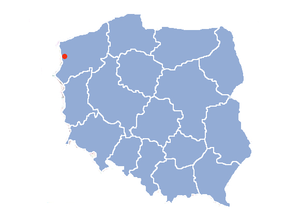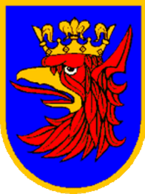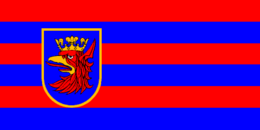Szczecin
| Szczecin | |||||
| |||||
| Motto: none | |||||

| |||||
|---|---|---|---|---|---|
| Voivodship | West Pomeranian Voivodship | ||||
| Municipal Government | Rada miasta Szczecin | ||||
| Mayor | Marian Jurczyk | ||||
| Area | 301,3 km² | ||||
| Latitude Longitude |
14°34' E 53°26' N | ||||
| Population - total - density |
413 600 1372/km² - | ||||
| Area code | (+48) 91 | ||||
| Car registration marks | ZS OOO1 to ZS 99999 | ||||
| Official website (in Polish) | |||||
Szczecin (formerly Stettin) is the 7th largest city in Poland and the second largest Polish seaport on the Baltic. It is also the capital of the West Pomeranian Voivodship. There are 419,000 inhabitants in Szczecin (as of 2004).
Szczecin is situated on both banks of the Oder River, close to the German border. The city is situated to the south of and around the greater bay into which the Oder river flows. The Western side is commonly called the Left Bank (Lewobrzeże), and the Eastern side the Right Bank (Prawobrzeże). Between them is an archipelago with many islands (mainly industrial areas with shipyards and sea-port infrastructure).
City name
Early medieval sources show: Stetin 1133, Stetyn 1188, Stityn 1251 which is the same to the modern Polish spelling of Szczecin. The name is almost certainly of the same origin as others Polish names such as Szczytno, Szczucin and Szczuczyn.
There are several possible etymologies of the city name:
- Szczecin comes from the word szczyt which means peak, hill top in modern Polish, but also a long shield in Old Polish. So Szczecin means a town located on a hill top, or a town fortified as a stronghold.
- Szczecin comes from a personal name Szczuka an means Szczuka's town
- Szczecin comes from a personal name Szczeta/Szczota an means Szczota's town
- Szczecin comes from a word szczecina which means bristle. So Szczecin is a town with many swines, or a town fortified like bristle.
Because in 1310 duke Warcislaw IV has founded a new city called New Szczecin and today Szczecinek modelled after the Szczecin municipality, the original Szczecin was sometimes called the Old Szczecin (Latin: Stetinum Antiqua, German: Alten Stettin, Polish: Stary Szczecin).
Demographics
12th century: 5,000 inhabitants
1720: 6,000 inhabitants
1740: 12,300 inhabitants
1816: 21,500 inhabitants
1843: 37,100 inhabitants
1861: 58,500 inhabitants
1872: 76,000 inhabitants
1890: 116,228 inhabitants
1910: 236,000 inhabitants
1939: 382,000 inhabitants
1945: ?
1950: ?
1960: 269,400 inhabitants
1970: 338,000 inhabitants
1975: 369,700 inhabitants
1980: 388,300 inhabitants
1990: ?
2000: ?
2002: 413,600 inhabitants
Economy
Szczecin is the biggest shipyard in Poland, which recently went bankrupt and was successfully reinstated. It has a fishing industry and a steel mill.
Major companies:
- Swedwood Poland SA, Szczecin
- Zespół Elektrowni Dolna Odra SA, Nowe Czarnowo
- Stocznia Szczecińska Nowa sp. z o.o., Szczecin
- Polska Żegluga Morska SA, Szczecin
- Netto Artykuły Żywnościowe sp. z o.o., Kobylanka
- Komfort sp. z o.o., Szczecin
- Petrocargo/OW Bunker sp. z o.o., Szczecin
- Vobis Microcomputer sp. z o.o., Szczecin
- PZE Cefarm-Szczecin SA, Szczecin
See also Baltic Sea Ports of 2002.
Sports
There are many popular professional sports team in Szczecin area. The most popular sport today is probably football thanks to Pogon Szczecin just promoted to play in the 1st league in season 2004/2005). Amateur sports are played by thousands of Szczecin citizens and also in schools of all levels (elementary, secondary, university).
Professional teams
- Pogon Szczecin - football team (2nd league 2003/2004, promoted to 1st league in 2004/2005),
- Arkonia Szczecin - football team (4th league in season 2003/2004)
- Pogon Szczecin II - 2nd Pogon fotball team (regional 4th league in season 2003/2004)
- KS Piast Szczecin - women voleyball team, (Seria A in season 2003/2004 and 2004/2005)
- Lacznosciowiec Szcecin - women handball team (1st league in season 2003/2004)
Amateur leagues
- Halowa Amatorska Liga Pilkarska - Hall Amateur Fotball League [1]
- Halowa Liga Pilki Noznej- Hall Fotball League
- Szczecinska Liga Amatorskiej Koszykowki - Szczecin Ameteur Basketball League [2]
- Szczecinska Amatorska Liga Pilki Siatkowej - Szczecin Ameteur Voleyball League [3] - women league, 1st, 2nd and 3rd men league
- Elita Professional Sport - Elita Hall Fotball League [4] - 1st and 2nd league, futsal cup
Politics and Administartion
Szczecin constituency
Members of Parliament (Sejm) elected from Szczecin constituency
- Artur Balazs, PO
- Wojciech Długoborski, , SLD-UP
- Wacław Klukowski, Samoobrona
- Bohdan Kopczyński, LPR
- Stanisław Kopeć, SLD-UP
- Bożena Kozłowska, Samoobrona
- Bogusław Liberadzki, SLD-UP
- Czesław Marzec, SLD-UP
- Jacek Piechota , SLD-UP
- Elżbieta Piela-Mielczarek, SLD-UP
- Elżbieta Romero, SLD-UP
- Jacek Sauk, PiS
- Krzysztof Zaremba, PO
Municipal politics
Szczecin is governed by city council and mayor. Mayor (prezydent miasta), as well as council, is elected by city's citizens every four years.
Marian Jurczyk, Solidarity icon, is Szczecin's mayor. His achievements are however widely criticised and he is blamed for over 10 millions zlotys compensations which city must pay for canceling the land selling deal, his lack of formal education, and his apparent cluelessness in many important matters. Mr Jurczyk famous errors includes forgetting the name of his own deputy he just nominated or quoting Jesus in his speech to the council.
Because of this criticism recall voices of recall were raised. On 23 March 2004 necessary 32 000 signatures were received by Recall Committee. Recall referendum took place on 23 May 2004. However the necessary 30% turnout wasn't reached as only 19% of voters cast their ballots. An overwhelming majority of those voting (92%), supported mayor's recall. This means that current political situation is quite difficult.
Administration
Szczecin is divided into the auxiliary local government districts called rady osiedla. Those districs elects it's own councils, and are responsible mainly for small infrastructure like trees, park benches, playgrounds, etc. Other functions are mostly advisory.
Architecture and urban planning
Szczecin's architectural style is mainly influenced by those of last half of 19th century and first twenty years of the 20th century mostly by Academic art and Art Nouveau. In many areas build after 1945 Social realism is prevalent.
Urban planning of Szczecin is unusual. The first thing observed by a newcomer is abundance of green areas: parks and avenues – wide streets with trees planted in the island separating opposite traffic (where often tram tracks are laid); and roundabouts. This makes Szczecin's city project quite similar to that of Paris. The reason is, Szczecin (like Paris) was rebuild in 1880s using a design by Georges-Eugène Haussmann.
This course of designing streets in Szczecin is still used, as many recently build (or modified) city areas include roundabouts and avenues.
History
A stronghold was built in the first half of the 9th century at the ford of the Oder river, (at the same location where later was a ducal castle) and a few craftsmen and traders settled in the vicinity.
It was the main centre of a small Western Slavonic tribe living in the fork of the Oder river between the main branch and the Randow river. It is not certain if this tribe belonged to the Pomeranians who lived on the right bank of the Oder, or to the Polabians or Veleti who lived on the left bank of the Oder. It is also possible that Stettin was controlled in some manner by both tribes. It is very likely that Mieszko I of Poland, who conquered Pomerania in the years 967–972, also took control of Szczecin and Wolin. Piasts rule in Szczecin was overthrown by pagan counter-revolution around 1005. In the coming century, Pomerania was few times subject of the attempts of central Polish government to unify again with the mainland. However, most of the time, Pomeranians kept their Slavic faith.
After the decline of Wolin in the 12th century, Szczecin became one of the most important and powerful cities of the Baltic Sea south coasts, having some 5,000 inhabitants. It was a city republic ruled by a class of rich nobility who were usually tradesmen, pirates and landowners.
In a winter campaign of 1121–1122, Szczecin was subjugated by Boleslaus II of Poland, who invited bishop Otto of Bamberg to baptize the citizens (1124). In the next years it was subjugated by the Warcislaw I, duke of Pomerania, who organized the second visit of Bishop Otto in 1128.
In the second half of the 12th century, a group of tradesmen from Holy Roman Empire settled in the city around St. Jacob's church, which was consecrated in 1187. Duke Barnim I granted a local government charter to this community in 1237, and a full location charter under the Magdeburg law in 1243. That community was growing, and later a Slavic community also settled around St. Nikolas church (in the neighbourhoods of Chyżyn, Upper Wik, Lower Wik).
In the years 1295–1464 Szczecin was the capital of a splinter Pomeranian realm known as the Duchy of Szczecin. (Its Dukes were Otto I, Barnim III the Great, Casimir III, Swantibor I, Boguslaw VII, Otto II, Cazimir V, Joachim I the Younger, Otto III)
In the 13th and 14th centuries Szczecin become the main Pomeranian centre of trade in grains, salt and herrings, receiving various trading privileges from their dukes (known as emporium rights). It was granted special rights and trading posts in Denmark, and belonged to the Hanse trading cities union. In the 14th and 15th centuries, Szczecin conducted several trade wars with the neighboring cities of Garz, Gryfino and Stargard Szczecinski over a monopoly on grains export. The grain supplying area was not only Pomerania but also Brandenburg and Greater Poland — trade routes along the Odra and Warta rivers. The 16th century saw the decline of the city's trading position because of the competition of the nobility, as well as church institutions in the grains exports, a customs war with Frankfurt an der Oder, and the fall of the herring market.
During the Thirty-Years War, Szczecin refused to accept imperial armies, and in 1630 was taken over by Sweden. After the death of the last Pomeranian duke, Boguslaw XIV, Szczecin was awarded to Sweden with the western part of the duchy in the Peace of Westfalia (1648). The city was thus cut off from its main trading area, and was besieged in several wars. It fell in economic decline.
In 1713, Szczecin was occupied by and in 1720 officially awarded by Sweden to Prussia. In the following years Szczecin became the capital of the Prussian province of Pomerania, and the main port of the Prussian state. From 1740 onwards, the Oder waterway to the Baltic Sea and the new Pomeranian port of Swinoujscie were constructed.
In the following years, large groups of French Hugenots settled in Szczecin, bringing new developments into the city crafts and factories. The population increased from 6000 in 1720 to 21'000 in 1816, and 58'000 in 1861. The 19th century was the age of large territorial expansion for the city, especially after 1873, when the old fortress was abolished. In 1821, the crafts corporations were abolished, and in steam transport on the Oder began, allowing further development of trade. The port was developing quickly, specialising in exports of agricultural products and coal from Silesia.
In 1843, Szczecin was connected by the first railway line to Berlin, and in 1848 by the second railway to Poznan. New branches of industry were developing, including shipbuilding (at the Wulkan shipyard) and ironworks using Swedish ores. The population grew to 236 thousand in 1910 and 382 thousand in 1939.
During World War II Szczecin was a main centre of weapons industry (including the car production Stoewer), and there were several slave workers camps in the city. 65% of Szczecin's buildings and almost all of the city centre, seaport, and industry was destroyed during the Allied airraids in 1944, and heavy fightings between the German and the Soviet Army (26 April 1945).
After WWII, the Allies moved the Polish-German border was moved to the west of the Oder-Neisse line. Most of Pomerania, including Szczecin and the Oder mouth, fell to Poland. The German inhabitants of Szczecin first fled from the city, but later returned as it was undecided if the city would be in Poland, or in the Soviet occupation zone in Germany. Many Germans also worked in the Soviet military bases that were outside Polish jurisdiction. In the 1950s most of the Szczecin's Germans left the city, although there was a significant German minority for the next 10 years.
The city was settled with the new inhabitants from every region of Poland, including those who lost their homes in the eastern Polish territories lost to the Soviet Union, especially people from Wilno. This settlement process was coordinated by the city of Poznan in Greater Poland.
From 1946 to 1998 Szczecin was the capital of the Szczecin Voivodship. The city changed borders in the administrative reorganizations in 1950 and 1975. Since 1999 it is the capital of the West Pomeranian Voivodship. In 1970 riots occurred in the city, see also Coastal cities events.
Dukes of Szczecin
- 1160-1187 Boguslaw I
- 1156-1180 Boguslaw I, Kazimierz I
- 1202-1220 Boguslaw II
- 1220-1278 Barnim I Dobry
- 1278-1295 Barnim II, Otto I and Boguslaw IV
- 1295-1344 Otto I
- 1344-1368 Barnim III Wielki
- 1368-1372 Kazimierz III
- 1372-1404 Swietobor I and Boguslaw VII
- 1404-1413 Swietobor I
- 1413-1428 Otto II and Kazimierz V
- 1428-1435 Kazimierz V
- 1435-1451 Joachim I Mlodszy
- 1451-1464 Otto III
- 1464-1474 Eryk II
- 1474-1523 Boguslaw X
- 1523-1531 Jerzy I and Barnim X
- 1531-1569 Barnim IX
- 1569-1600 Jan Fryderyk
- 1600-1603 Barnim X
- 1603-1606 Boguslaw XIII
- 1606-1618 Filip II
- 1618-1620 Franciszek I
- 1620-1625 Boguslaw XIV
External links
Internet guides
Regional media
- Głos Szczeciński, regional daily newspaper
- Kurier Szczeciński, regional daily newspaper
- Radio Plus Szczecin, regional radio station
- Radio Szczecin, regional radio station
- Regional TV station
- local edition of Gazeta Wyborcza
- Wirtualny Szczecin
History and culture
- Pomeranian Dukes Castle in Szczecin (Polish, German, Enghlish)
- Opera in the Castle
- Polish Theatre
- Modern Theatre
- Kana Theatre
Economy and transportation
- Szczecin-Świnoujscie Seaport
- Polferries - Polska Żegluga Bałtycka
- UnityLine
- Szczecin-Goleniów Airport
Science and Education
- Szczecin University
- Technical University of Szczecin
- Pomeranian Medical University (Pomorska Akademia Medyczna)
- Maritime University of Szczecin (Wyższa Szkoła Morska)
- Akademia Rolnicza, Agriculture Academy
- Collegium Balticum
- Wyższa Szkoła Humanistyczna, Humanities College
- Wyższa Szkoła Integracji Europejskiej, European Integration College
- Wyższa Szkoła Zarządzania, Management College
- Wyższa Szkoła Zawodowa Oeconomicus, Oeconomicus College
- Zachodniopomorska Szkoła Biznesu, West-Pomeranian Business College

